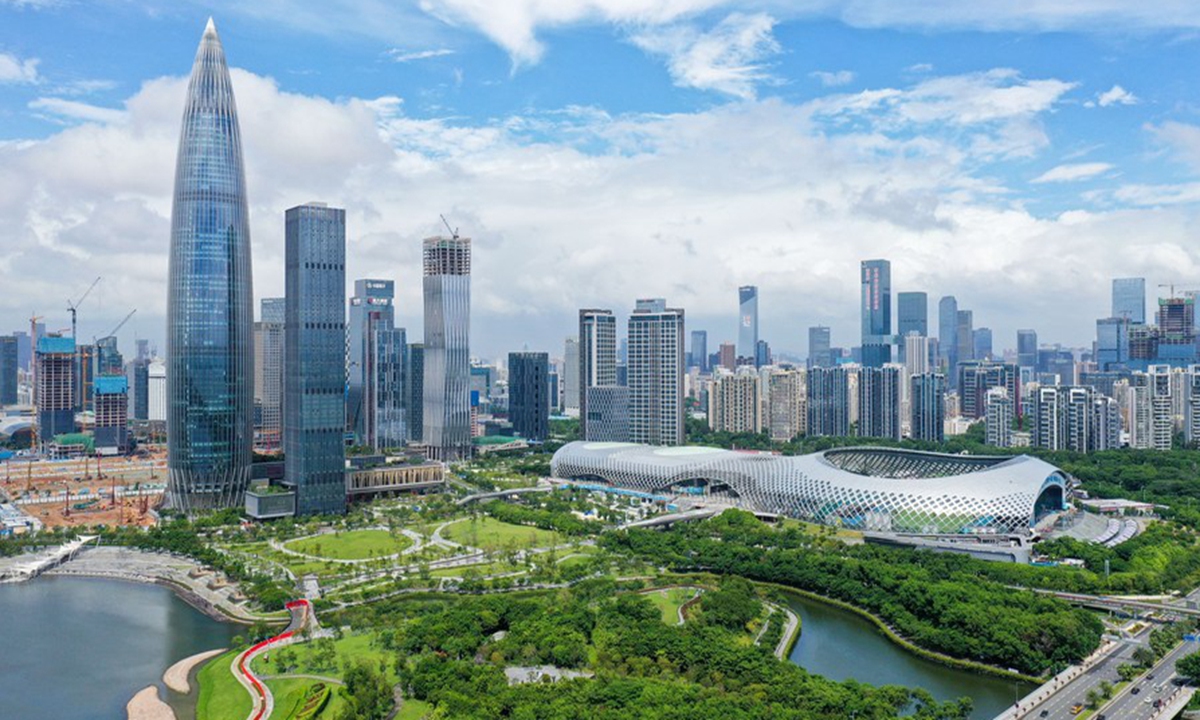发布时间:2022-04-20 作者: 罗思义
国际经济形势正在恶化。国际货币基金组织已经宣布下调143个国家的增长预测。美国的通货膨胀率达到8.5%,是40年来的最高值。
作者罗思义系中国人民大学重阳金融研究院高级研究员、伦敦经济政策署前署长,本文刊于2022年4月20日环球时报,英文版刊于4月17日Global Times。
国际经济形势正在恶化。国际货币基金组织已经宣布下调143个国家的增长预测。美国的通货膨胀率达到8.5%,是40年来的最高值。通胀调整后,美国的工资在去年下降2.7%。高通胀率迫使美联储提高利率。在其他发达经济体,通货膨胀率更高:西班牙和荷兰分别是10%。随着增长放缓和通胀率上升,世界大部分地区的经济正在走向“滞胀”。面对这一不利的国际趋势,中国正确地推出一项温和的经济刺激计划,下调存款准备金率就证明了这一点。
与这些国际趋势相比,即便是粗略的事实考察也表明,中国经济是迄今为止最强大的全球稳定和增长中心。中国的通胀率为1.5%,完全可控,不到美国的1/5。自新冠肺炎疫情出现以来,中国的GDP增长10.5%,美国GDP增长2.1%。中国的经济增长速度是美国的5倍。
尽管存在这些明显的事实,美国媒体仍在试图宣称,由于上海疫情和俄乌冲突,中国面临严重的经济问题。这与已经存在的主要事实相去甚远,很容易让人将其视为纯粹的宣传而不再关注。尽管如此,进一步探讨这些假新闻仍具有一定意义,因为它们表明了世界经济的真实状况以及中美在其中的地位。
关于新冠肺炎疫情,美国的说法可以立即被驳回。上海的疫情与美国相比微不足道。本文撰写的当天,中国因新冠病毒死亡人数是个位数,而作为一个不到中国1/4人口的国家,美国这一天的新冠死亡人数为59人。如果美国的人口与中国一样多,美国每天的死亡人数将超过数百人。自疫情暴发以来,中国总共有4600多名新冠患者死亡,而美国是超过100万人。
在经济方面,中国的表现同样远超美国。事实上,美国的政策正在破坏自身和世界经济的稳定。
美国财政部长耶伦曾试图宣称,美国通胀率飙升的原因是乌克兰战争带来的“巨大”影响。这完全不符合事实。到目前为止,美国通胀浪潮的最大部分先于乌克兰冲突出现。美国通胀率从2020年1月的2.5%升至2022年1月的7.5%。正如《华尔街日报》所言:“这不是普京的通胀。”
引发这波通胀浪潮的,是美国政府为应对新冠肺炎疫情而推出的一揽子刺激计划。在阐明经济趋势的同时,我们不妨将美国经济刺激计划和中国经济刺激计划进行对比,就很能说明问题。
自新冠肺炎疫情以来,美国在2020年12月启动9000亿美元的预算刺激计划,2021年3月又加上1.9万亿美元,总计2.8万亿美元。美国政府债务占GDP的比重达到27%的峰值,货币供应量同比增长27%,两者都创下美国和平时期的历史新高。从结构上看,这些一揽子计划完全着眼于消费,也就是经济的需求端。从2019年到2021年,美国GDP增长的98%来自消费,净投资仅占2%。需求增长巨大,而供给和投资几乎没有增加。这不可避免地点燃了美国的通货膨胀浪潮。《华尔街日报》也说:“华盛顿制造了通货膨胀。”
2022年年初的数据证实,中国启动温和的经济刺激计划:不仅注重消费,也注重投资。一季度中国GDP同比增长4.8%,其中社会消费品零售总额增长3.3%,固定资产投资同比增长9.3%,工业增加值同比增长6.5%。与美国不同,中国的均衡发展没有导致明显的通货膨胀。
因此,面对不利的国际形势,中国有在必要时放松货币政策的空间,美国则被高通胀困在货币紧缩中。总之,中国不仅在过去一段时间里表现优于所有其他主要经济体,而且显然处于继续跑赢所有主要经济体的最佳位置。
以下为英文版:
China still the backbone of world economy

The Houhai area in Nanshan District of Shenzhen, south China's Guangdong Province, September 17, 2020. Photo: Xinhua
The international economic situation is sharply worsening. The IMF has announced a downgrade of growth predictions for 143 countries. US inflation has reached 8.5 percent, the highest in 40 years - US inflation-adjusted wages fell 2.7 percent in the last year. High US inflation is forcing the Federal Reserve to raise interest rates, slowing its economy. In other advanced economies, inflation is higher - in Spain and the Netherlands it is 10 percent. With slowing growth and rising inflation, much of the world economy is heading towards "stagflation." Confronted with negative international trends, China's economy has rightly launched a moderate stimulus package - shown recently by reduction of China's Reserve Requirement Ratio.
Compared to these international trends, even a cursory factual examination shows that China's economy is by far the most powerful global centre of stability and growth. China's inflation is 1.5 percent - fully in control and less than one fifth that of the US. In the two years since COVID-19 began, China's GDP has grown by 10.5 percent and US' by 2.1 percent - China's economy growing five times as fast as US economy.
Despite these obvious facts, US media claim that due to Shanghai's COVID-19 outbreak and the Russia-Ukraine conflict, China faces serious economic problems. This is so far out of line with the major facts already given it is tempting to dismiss it as pure propaganda and pays no more attention. Nevertheless, it is instructive to look further into this falsification as it indicates the real situation of the world economy and the place of China and the US within it.
Regarding COVID-19, US claims can be dismissed immediately. Shanghai's COVID-19 outbreak is significant, but China is suffering zero daily deaths whereas the US suffered 956 in a country with less than a quarter of China's population. If the US had the same population as China, the US would be suffering over 4,000 deaths daily compared to China's zero. Since the pandemic's outbreak, the Chinese mainland has suffered 4,638 deaths compared to the US' almost 1 million.
Turning to the economy, China is similarly far outperforming the US. Indeed, US policy is destabilising both itself and the world economy.
US Treasury Secretary Janet Yellen claimed that US inflation surge was due to the "enormous" economic effects of the Ukraine war. This is entirely untrue. By far, the largest part of the US inflationary wave came before Ukraine. US inflation rose from 2.5 percent in January 2020 to 7.5 percent in January 2022. As the Wall Street Journal noted, "This Isn't Putin's Inflation."
What created this inflationary wave was the type of US stimulus packages launched in response to COVID-19. As it clarifies economic trends, it is illustrative to compare this failure of the US stimulus packages to those launched in China.
Since COVID-19 began, the US launched a budgetary stimulus of $900 billion in December 2020, and $1.9 trillion in March 2021 - $2.8 trillion in total. The US government borrowing peaked at 27 percent of GDP and US money supply increased by 27 percent year on year - both the highest in US peacetime history. Structurally, these packages completely focused on consumption - on the economy's demand side. From 2019-21, 98 percent of increase in US GDP was in consumption and only 2 percent in net investment. With a huge demand increase, and almost no increase in supply and investment, inevitably a huge US inflationary wave was ignited. As the Wall Street Journal put it, "This inflation was made in Washington, D.C."
Compare China's 7 trillion yuan stimulus package to counter the 2008 international financial crisis. This focused not only on consumption but on investment - the economy's supply side. In two years following the launch of this package, 46.3 percent China's increase in GDP was in consumption and 39.9 percent in net fixed investment. China's stimulus package was a balanced mixture between the economy's supply and demand sides. China's economy far outperformed that of the US - since 2007 the US economy grew by 24 percent while China's grew by 177 percent.
The same is occurring now. Data for the beginning of 2022 confirms China launched a moderate stimulus package - again focused not only on consumption but also investment. Taking January-February compared to December the annual increase in retail sales rose from 1.7 to 6.7 percent, fixed investment rose from 4.8 to 12.2 percent, industrial production rose from 4.3 to 7.5 percent. Unlike the US, China's balanced development led to no significant inflation.
China therefore has space to loosen its monetary policy, if necessary, faced with negative international trends - unlike the US which is trapped by high inflation in monetary tightening. In summary, not merely has China outperformed all other major economies in the last period, it is clearly in the best position to continue to do so.
(欢迎关注人大重阳新浪微博:@人大重阳 ;微信公众号:rdcy2013)